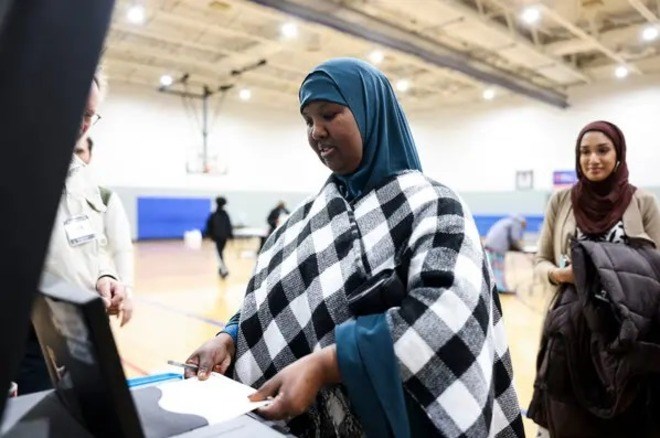
Sunday September 22, 2024

Hibak Mohamed, a Minnesota voter, casting her ballot at a polling site in a Minneapolis gymnasium. Credit / Jenn Ackerman for The New York Times
MINNEAPOLIS, Minn (HOL) — Despite Minnesota’s efforts to ensure accessible voting, language barriers remain a significant hurdle for Somali-speaking residents in Stearns County. With no legal requirement for Somali interpreters at polling stations, many eligible voters face difficulty casting their ballots due to limited English proficiency.
According to Minnesota law, voting materials are provided in Somali, Spanish, and Hmong, reflecting the state’s most commonly spoken non-English languages. However, these provisions only assist voters who are literate in their native languages. In Stearns County, Somali-speaking residents do not meet the 20% threshold in any census tract that would mandate the presence of an interpreter, leaving many voters dependent on family members or community volunteers for assistance.
During the August 13 primary election at the Stearns History Museum, election judges who primarily spoke English faced challenges while assisting Somali residents registering to vote. While officials worked diligently, the absence of a shared language complicated the process, illustrating the broader issue that impacts Somali voters statewide.
Minnesota’s 2023 update to voting statutes allows voters to bring an interpreter of their choice to polling locations. It also lifts the previous limit, enabling individuals to assist as many voters as needed. However, the absence of interpreters at some polling sites poses a barrier for those without access to personal interpreters, especially in smaller counties like Stearns.
Stearns County, home to a growing Somali population, remains underserved in terms of voting assistance. According to the 2020 U.S. Census, over 8.7% of St. Cloud households speak languages other than English. However, despite their growing presence, Somali voters still struggle to access necessary resources at the polls.
State law mandates the availability of voting materials in multiple languages if 3% or more of a U.S. census tract’s population speaks a non-English language. In Stearns County, Somali speakers do not meet this threshold, making it harder for non-English speakers to navigate the voting process. Meanwhile, St. Cloud has nine precincts that offer Spanish or Hmong-language assistance, leaving the Somali community at a disadvantage.
Abdi Daisane, a Somali-American candidate running for Minnesota’s House of Representatives, has advocated for the Somali community in St. Cloud. Having become a U.S. citizen in 2014, Daisane has consistently volunteered to interpret for Somali voters, underscoring the need for more formalized language support at polling locations.
“Many in our community want to vote but face significant challenges,” Daisane said. “We must ensure that everyone, regardless of language, can participate in the democratic process.”
Daisane noted that many Somali voters, particularly elders, face literacy challenges that make translated materials ineffective. “For some, even the best translations aren’t enough, because they can’t read in any language, including their native Somali,” he said. “In those cases, having an interpreter is crucial.”
In the absence of mandatory interpreters at polling sites, the Minnesota Secretary of State’s Office recommends early or absentee voting as an alternative for those who need more time to review ballots with help from interpreters. Somali-speaking voters can access election resources, including the guide “Codbixinta Minnesota Gudaheeda” (“Voting in Minnesota”), through the Secretary of State’s website.
Additionally, organizations like the American Civil Liberties Union (ACLU) of Minnesota offer voter assistance hotlines in various languages, including Somali, providing critical support to non-English-speaking voters statewide.
As the Somali population in Minnesota continues to grow—particularly in Greater Minnesota—the need for language assistance at polling sites is expected to increase. With over 34.3% of Somali speakers reporting limited English proficiency, expanded resources and formalized interpreter services will be key to ensuring broader participation in elections.
While Minnesota has made strides toward inclusivity in voting, advocates like Daisane emphasize that much work remains. For Somali voters, having access to interpreters and voting resources will be essential in overcoming the barriers that currently limit their participation in the democratic process.
For more information on voting in Minnesota, visit the Secretary of State’s website or access Somali-language resources directly at www.sos.state.mn.us/elections-voting/somali.






